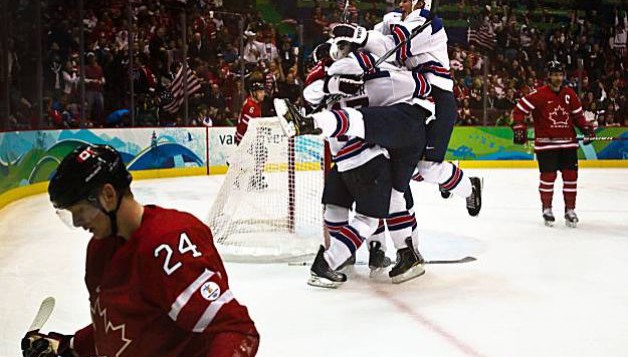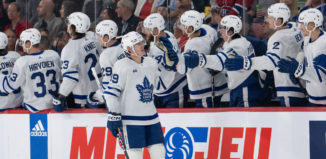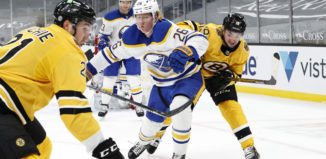Projecting the Stars & Stripes: Part Two – Defense
(Photo: Smiley N. Pool, Chronicle Olympic Bureau)
By Andrew Imber
Defense is such an incredibly underrated position in hockey. It is responsible for so many different aspects of the game. They obviously provide what their very position says – they help the goalie to defend. They also contribute offense in many situations, providing the first big pass up the ice, or even skating it all the way themselves. Defensemen must also take the body to prevent opposing forwards from entering the zone. Some specialize in just one of those skills, and others are quite capable of doing it all.
There is no grouping that is more difficult to narrow down for the United States Olympic Team than the defense core. Without a doubt, the United States would be more than comfortable sending two different sets of six blue liners to Sochi, and feel pretty competitive at the position. It is not as though they have an embarrassment of riches, but they really do have an embarrassment of solid, strong depth. There are a couple of guys who will be able to shut things down, and the rest can provide steady play to keep the squad competitive.
This is where the scouts and USA Hockey team really earn their money. They have to find a way to differentiate between many similar talents, and also tailor a unit that will be mobile enough to most effortlessly negotiate the larger ice surface. As we’ve already mentioned, one bobbled puck can be the difference between ultimate jubilation and complete failure. What sounds like a dramatization is simply the cold reality of a tournament where you have three games to advance to a single elimination process.
Ryan Suter – Paul Martin
Ryan McDonagh – John Carlson
Jack Johnson – Erik Johnson
Extras: Keith Yandle, Cam Fowler
Locks (2): Ryan Suter, Ryan McDonagh
For a while, as Ryan Suter and Shea Weber formed an incredible pairing for the Nashville Predators, many wondered if Weber was making his partner look good. Fast forward to Ryan Suter in Minnesota, and it has become clear that Suter is one of the NHL’s best, while Weber has struggled at times to adjust to life without the American blue liner. Suter will be the main man for the United States, playing in every situation and probably more than half the game every night. Ryan McDonagh started off slow this season, but has really become the only constant for a struggling Rangers squad. Though the Rangers rank near the bottom of the NHL in scoring, he is on pace to break 40 points from the back end, while still providing lock down defense. Expect each Ryan to anchor a top four pairing for the red, white and blue.

(AP Photo/Matt Slocum)
Ryan Suter will have an even larger role in Sochi.
Probable (3): Paul Martin, Jack Johnson, Erik Johnson
One of the most difficult distinctions for this grouping is what separates a player from probable and bubble. If you really want to get right down to it, the skill level is probably pretty similar between the defense in this category, and those that are in my bubble. So why are these three here? Each player has enough going for them to have better odds than the rest. Paul Martin is a steady rock of a defenseman, and is my personal choice to play with Suter on the top pair. Although Kris Letang gets all the attention (and award consideration) in Pittsburgh, most Penguins fans will tell you that Martin is the much better all around guy. Don’t forget, he was chosen for the 2010 squad, but missed due to injury. He also has the benefit of having his NHL coach as the team’s coach. Ironically, only his current injury is capable of keeping him off the roster, yet again.
If all things were equal in this world, Jack Johnson would be lucky to be on my bubble. But, anybody familiar with USA Hockey knows that this is not the case. Jack Johnson has answered the call for the United States on every single level, always playing in the World Championships, where others turned it down. If that, alone, doesn’t give him an edge, the fact that he always steps up and plays well for his country is probably enough to earn him a spot. His pedestrian NHL numbers (and career plus/minus of -99) would not be enough to garner consideration, but his loyalty to the program will probably be rewarded. Plus, his familiarty with the squad means he has played on the large ice surface many times, and that counts for a lot. Erik Johnson was probably a bubble player, at best, coming into this season, but he has enjoyed a very nice breakout campaign with the impressive Colorado Avalanche. Erik has experience playing in the World Championships and the Olympics, and his strong season should earn him a spot in Sochi.
Bubble (7): John Carlson, Keith Yandle, Cam Fowler, Dustin Byfuglien, Kevin Shattenkirk, Justin Faulk, Brooks Orpik
The bubble is quite large when it comes to American defensemen, and there is no doubt that the official announcement will come with some controversy, no matter who is selected. My personal pick from the bubble for the final top six spot is John Carlson. The young blue liner has finally been given a larger role in Washington, adding top power play time to his big minutes. While he has benefited from a steady partner throughout his NHL and even AHL career (Karl Alzner), Carlson does so much well and did come up huge for the United States Junior team with an OT Golden Goal in 2010 against Canada. If he isn’t the choice, Keith Yandle would be an intriguing pick. Known mostly for his offensive and power play specialty, Yandle could be dangerous on the large ice. Chances are, at least one of Yandle or Cam Fowler will make the team, as Fowler plays a similar offensive type role. Fowler has been a top defenseman for an incredible Anaheim team and his skating is virtually unmatched at his position. Currently, I have both Fowler and Yandle on my team, but if the USA is looking for some diversity, I would not be surprised to see one go, and a more all around or physical defensemen chosen instead.
No conversation about offensive blue liners would be complete without mentioning Dustin Byfuglien. You can’t discuss his candidacy without some joker bringing up his weight concerns, but a fit Byfuglien is on pace for yet another 50 point season. Byfuglien could come as a power play specialist, or he could even be used as an extra forward. If Canada happens to go with Roberto Luongo as their goaltender, I would love nothing more than to see Byfuglien buzzing in front of his net and causing problems, much as he did with Chicago years ago. A guy who I’ve seen as high as top pairing projected to as low as off the team, Kevin Shattenkirk is an interesting consideration. He has just one point less than Byfuglien this year, but it is hard to ignore his secondary role in St. Louis. Playing behind Alex Pietrangelo and Jay Bouwmeester comes with some advantages, though Shattenkirk could easily play a similar role if he was selected for a bottom pair on this team. Justin Faulk is a guy that draws rave reviews every time he plays for the United States internationally (he went point-per-game in the ’12 World Championships), but that hasn’t carried over to much sustained NHL success or production. He’s the type of guy who might be a somewhat controversial pick, but could flourish in the tournament. Brooks Orpik is available if the United States wants a physical, net-clearing presence, and also if they want chemistry with Paul Martin.
There will be many deserving players that get left off of this roster, but the good news is many of these defensemen are just beginning their careers. The United States has a very bright future on defense, and this is without mentioning Seth Jones, who will add to a formidable future grouping. We finish our United States roster projection next with a look at the goaltending situation.














